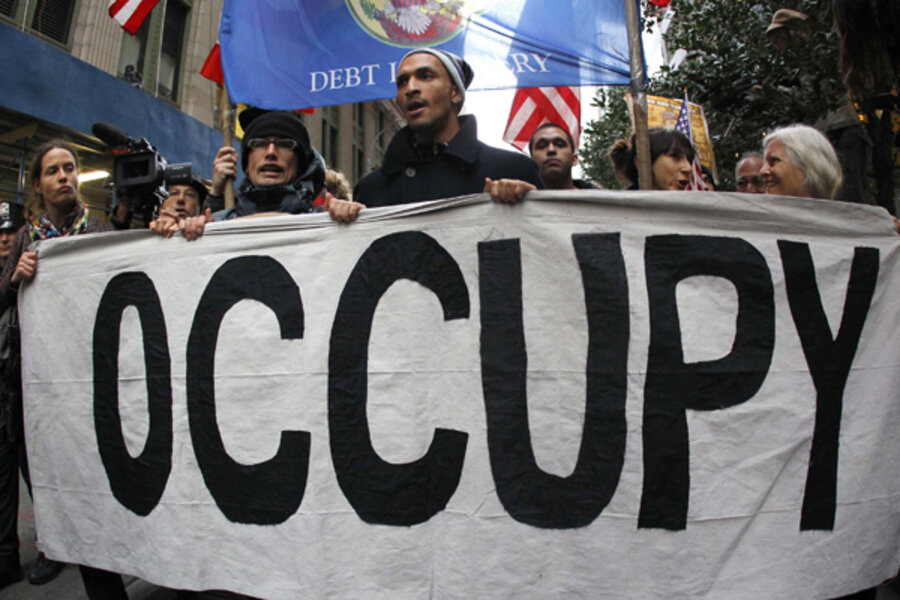New York braces as Occupy Wall Street protesters target stock exchange
Loading...
It's hard to figure how the Occupy Wall Street protesters, who vow to shut down the New York Stock Exchange Thursday morning, will manage to achieve their aim, given the high-stakes game of cat and mouse that activists and city officials have been playing since a second clearing of the Zuccotti Park protest encampment on Tuesday.
Police have the Wall Street area under heavy security, with blockades and barriers at every turn. On Monday, Mayor Michael Bloomberg said the stock exchange would open and people would be able to go to work, “rest assured.”
Demonstrators are prepared, anticipating that they may be arrested in droves. At Wednesday-evening training sessions, experts in nonviolent protest tactics advised the activists on everything from how to dress for jail – in layers, as it could be very warm or very cold – to the strategies for one-on-one confrontations with police and tear gas. Lisa Fithian, who helped organize the 1999 World Trade Organization protests in Seattle, kicked things off with a series of role-playing games, according to Josh Harkinson, who describes the session on the Mother Jones website. “People pretending to be NYSE workers, police, and members of the media offered challenges,” he writes, noting that the group practiced ways to block streets and get arrested gracefully.
Ms. Fithian contrasted two ways of interacting with police – demonstrating why the latter is preferable, he recounted. "Does somebody want to be a cop and come get me?" asked Ms. Fithian, he wrote, noting that a young woman with curly red hair chased her around the room. “Then she demonstrated another approach: As a big guy in dreadlocks rushed her, she slowly backed up and said, 'Officer, I'm cooperating!' " Then she drove home her point. "What was demonstrated by running away? she asked. 'Guilt. We are doing something wrong.' "
Protesters in New York plan a classic sit-in, locking arms in front of the New York Stock Exchange entrance, with strict instructions not to resist arrests.
Will they stop the morning bell from ringing, or for that matter even significantly disrupt the trading day?
“Probably not,” says Cornell University's Robert Hockett, a finance law professor who has an office around the corner from Zuccotti Park and who has joined several finance-related working groups that are part of the Occupy Wall Street coalition. Even if protesters manage to slow the flow of traders accessing the exchange floor, he says, it will matter very little. “There are many ways for traders to conduct business,” he says, including through other exchanges or over the counter.
But, he says, this is somewhat beside the point. Even a casual tourist will encounter layers of security before being allowed to enter the exchange in carefully escorted small groups. Mr. Hockett, who recently went to the trading floor to be interviewed and is there on official business, says he had to go through the same procedures. “It’s inconceivable [that protesters can enter the exchange building], unless they have some sort of spy,” he says with a laugh.
However, high-profile demonstrations – as Thursday's is certain to be – have their own logic, Hockett adds. “This is part of the ongoing, eminently teachable moments that have made up the Occupy Wall Street actions,” he says. By pointing the finger at the national symbol of financial activity in this country. the Occupy movement has started a dialogue about the role of finance in a highly developed country.
“I actually saw a placard being carried by one demonstrator that read, ‘Credit Union Power,' ” he says. The protest "will help continue the very important dialogue about the role of financial institutions in our national economy.”
The morning blockade kicks off a day of global action, celebrating what would have been the two-month anniversary of the Wall Street tent site. Actions are being planned everywhere from Spain to Chile to Australia. In New York City, a flier calls for demonstrators to gather at 3 p.m. EST in 16 different subway stations throughout the five boroughs to "listen to a singular story from one of our hardest-hit and most inspirational neighbors." A 5 p.m. celebration will kick off at nearby Foley Square, followed by a "march to our bridges, where we will demand that we get back to work rebuilding our country's infrastructure."
Fithian put the protest in context during the training, Mr. Harkinson notes in his account. "Everything that we do is part of patterning a new world," she said. "When Perestroika happened, when the Soviet Union turned to Russia, people said, 'What did it look like?' A man went to his wall, took his painting off, turned it upside down, and put it back on the wall. He said, 'That's what it was like.' "





